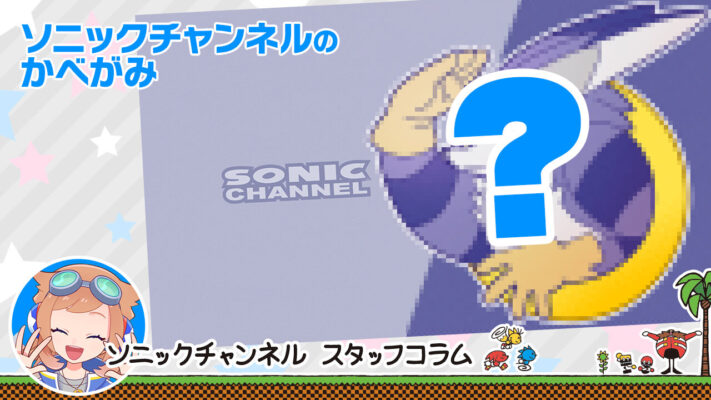When was the last time music moved you?
I remember exactly “when” that was. Because the updates for the iPod Classic, which I have been using for more than 15 years, have not been offered since 2010.
My iPod Classic, which contains tens of thousands of songs mainly in the genres that are often called “post-hardcore” such as emo, screamo and metalcore, doesn’t contain a single song from 2010 onwards. It’s not because I’ve moved to a subscription service, or I’m listening on my iPhone, or anything like that, it’s simply because I don’t want to put songs on it anymore. In short, I’m no longer moved by new music.
One possible reason why my heart is no longer moved is that the trends in the post-hardcore world have changed since around 2010. It may be that I myself can no longer keep up with the music that is changing with the times. Or it could be that my passion for music has waned as I’ve gotten older. As someone who devoted my youth to music, I think it would be very sad whether it was the former or the latter.
More than 10 years have passed since I stopped updating my iPod Classic. Even after 2022, I was still listening to post-hardcore music from the 00s, but I was shocked when I heard “a certain song” released in September 2022.
Then there was “I’m Here”, the main theme of Sonic Frontier.
The song starts off with a quiet piano intro, but then the guitars and drums start to roll in, and it’s just so massive. Above all, I couldn’t get enough of the high tone voice that accompanied the heart-wrenching melody. I really got goosebumps, and I don’t mean that in a metaphorical way.
Not long after that, I was shocked again when I heard the battle song “Undefeatable” from the Titan battle during a Sonic Frontiers test drive.
From the first second it’s got my heart…!
My heart, which had not moved for more than 10 years, was moved very easily. And in rapid succession. Is such a thing possible?
The main theme song “I’m Here” and the battle song “Undefeatable” for the Titan battle were created by Tomoya Ohtani, the sound director for Sonic Frontiers. He has been in charge of music for the Sonic series since Sonic Adventure 2 released in 2001.
So this time, Den-Fami had the opportunity to speak directly with Mr. Ohtani. What elements are packed into these songs? And how does he choose the artists he uses? In this article, we’ll be looking at Sonic Frontiers from the perspective of post-hardcore and other musical genres.
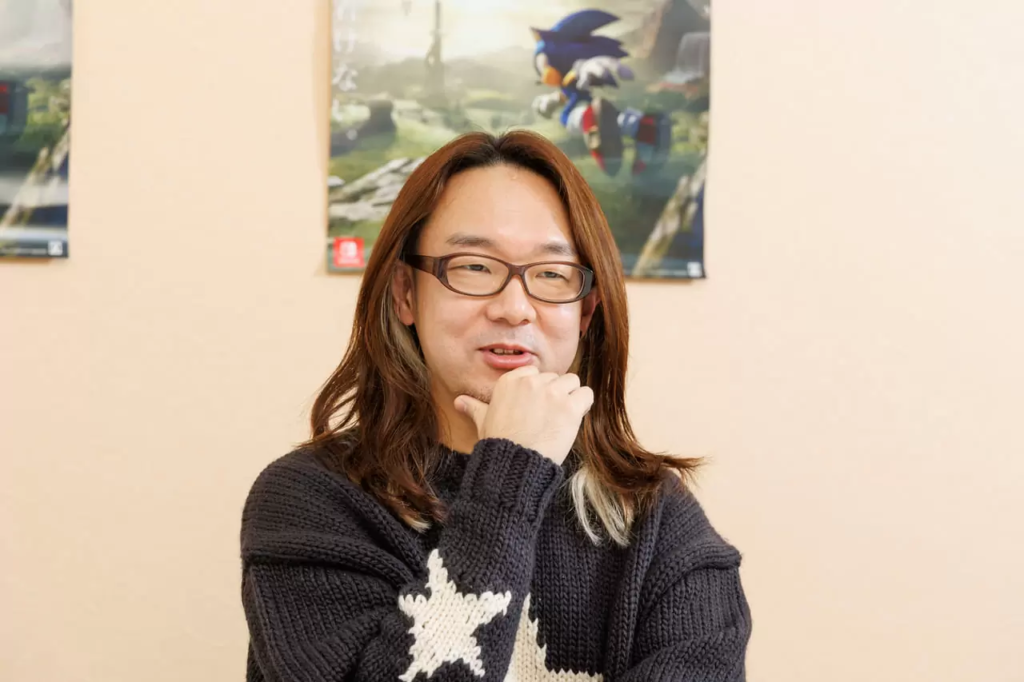
The same sound design as in the previous games in the series doesn’t fit Sonic Frontiers.
─ I’ve heard that you’re trying something different in terms of promotion, such as changing the key visuals for Europe, America, Japan and Asia. Is there a different approach to the music as well?
Ohtani: Sonic Frontiers is a different game than previous titles, so we thought the music should follow suit. In the past, the sound design for the Sonic series started with a groovy song in the first stage, and then a different groovy song in the next stage, so no matter where you turn, you’ll hear music that gives you an uplifting feeling as you play an action game.
However, we didn’t think that methodology would work for Sonic Frontiers. No matter how positive Sonic’s character is, it wouldn’t be right if he was alone on the Starfall Islands and bright, cheerful music started playing.

I thought it was necessary to change the approach to the music in order for people to get into Sonic’s situation and story. In the original draft of the project, there was a key word “solitude” written in. That was very easy to understand.
However, it took us a while to settle on where and how we wanted to make the game more exciting. We were also going through a lot of playtests and trial and error to make the battles with the guardians and the battles against the Titans more fun to play.

─ I’ve heard that some of the guardians were created through playtesting. What was the response to the music?
Ohtani: In the last playtest, the songs that got the most comments were the one for the Titan battle and the one for the fishing grounds.

─ Those two songs were very impressive. The battle song for the battle against the Titan is catchy from the start, was that part of the goal as well?
Ohtani: The battle against the Titans is also the moment when all the Chaos Emeralds come together and you become Super Sonic, so I made the song with the timing of when it would start playing in mind. I wanted that moment to be dramatic and memorable right from the start.
The battle music for the battle against the Titans and the music for the fishing grounds are two songs that really swing the musical presentation in Sonic Frontiers. We wanted the battles against the Titans to be exciting, and the fishing spot to be relaxing. We wanted the gap between the two to be bigger than usual.
─ It’s true that there’s so much of a gap between those two songs that it’s hard to believe they were written by the same person (laughs).
All of us: (Laughter).
Ohtani: The fishing grounds song was one I was working on early on in the project. It’s a genre of lo-fi hip-hop that I’ve always liked, and I wanted to make this kind of music, and then I found out that there was a fishing spot in Sonic Frontiers, and I thought, “This is it!” (laughs).

─ I was surprised because I didn’t think that fishing and lo-fi hip-hop would go together so well.
Ohtani: I think the point of the fishing spot in Sonic Frontiers is to “take a break”. Once you’re in the open zone, you’ll be battling all sorts of enemies, but here you can relax, immerse yourself in fishing, and even get some useful items for the adventure. When I thought about it, I thought lo-fi hip-hop would be a good fit.
I wanted to make more songs like this because it’s the kind of music I’ve always liked, but that’s not the same as enriching Sonic Frontiers with only fishing grounds songs, so I decided to satisfy that desire on my YouTube channel (laughs).
─ And the songs in Cyber Space are different on each stage, aren’t they?
Ohtani: We made as many songs for Cyber Space as there were stages. The reason for this is that each stage has a different level design. When you find the entrance to a new Cyber Space stage in the Open Zone and enter, we wanted to make it fun for you to wonder what kind of music will play in the next stage.

In the same way, each Guardian battle has a unique design and a different fighting style. I decided that if they were so different, I would make an original song for each of them.
─ I see. So you created the necessary songs for each stage and each game, and ended up with a huge soundtrack of 150 songs on 6 CDs.。
Ohtani:That’s right (laughs). Another reason why the soundtrack is a six-disc set is not only because of the number of songs, but also the length of each song. Open zones, where players can freely explore, take longer, so the songs are also longer.

─ You mean that the intervals between loops are long to begin with. I’ve heard it said that “the best thing about game music is that it can loop”, but if the duration of the loop is long, you have to make each song longer even if you want to loop it.
Ohtani: That’s right. The average play time for Cyber Space is 90 to 120 seconds per stage, and even if you take the collectibles, it’s supposed to take about two and a half minutes to reach the goal, so we’re aiming for about a minute and a half for one loop. However, when it comes to open zones, the time spent is different for everyone, so we thought we needed to be creative about that.
That’s why each song in the open zone is about 5 to 6 minutes long. Also, the story progresses as you collect Chaos Emeralds, so the songs change to the next level depending on when you get the Chaos Emeralds. That’s why we prepared about seven levels of music for each island. That’s one of the reasons the volume of the soundtrack is so large.
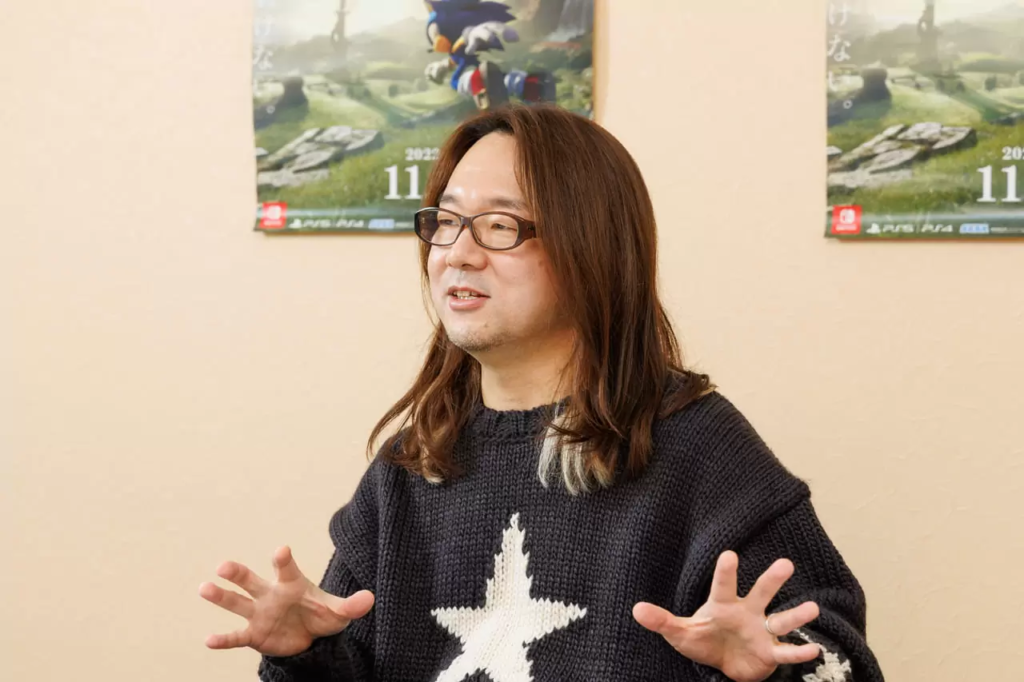
I don’t know if that was the right thing to do as a sound director, but the truth is that for Sonic Frontiers, we didn’t make a list of how many songs we were working on as a whole (laughs).
─What? (Laughs).
Ohtani: But we do keep track of each category. For example, island, cyber space, guardian battles, stage accompaniment, vocal songs, and so on. But we didn’t count the total number of songs because we didn’t think it would make sense to do so during development (laughs).
When it came time to make the soundtrack, I didn’t want to be asked “How many discs do you think it will be? I didn’t want to be able to answer that question, so I didn’t count them until the end of the project.
─ That’s a very luxurious process, isn’t it?
Ohtani: That’s right. I think it was an environment where we were not restricted in any way during the production period, and we were able to stick to the specifications as much as we could.
There’s a “cinematic” sense prepared for the music production.
─ Which song in Sonic Frontiers do you have a particular attachment to, Ohtani-san?
Ohtani: The main theme and the battle songs for the battle against the Titans are important songs, so of course I’m very attached to them, but another thing I couldn’t talk about during the promotion period before the release was the songs that play during the story part of the game. “How do I use music to express the changes in the mind of the character Sage?” Was what I was focused on

Sage is almost as much a main character as Sonic, and it’s no exaggeration to say that the story revolves around her. Director Kishimoto was also very attached to the character, so it was important for us to find the best way to portray her. I want the music that plays in the game to leave a lasting impression on everyone.
─ What kind of music is it?
Ohtani: Director Kishimoto suggested that we should use music to create an impressive performance. If we could do that, we would love to do it.
However, if you’re going to do that, you’re going to need to create a scene where the music is a part of it to some extent. In the Sonic series so far, we’ve never created a cutscene where the music is a part of the performance. There is one scene in Sonic Frontiers that I had added for the music. That scene is very important when following the character of Sage, so we added it to…….
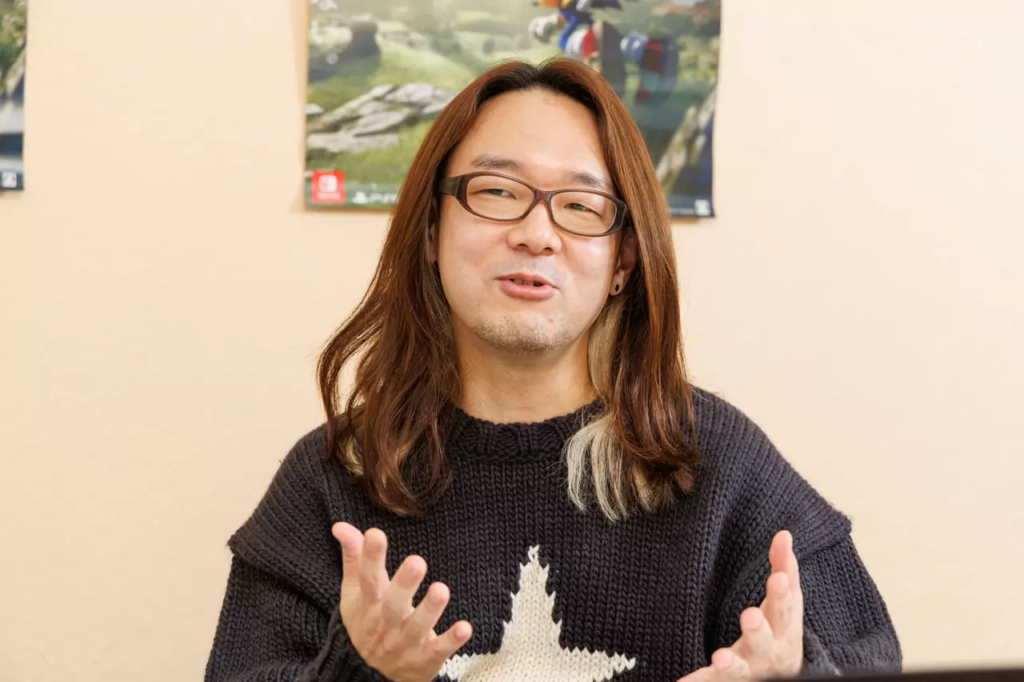
The song was written by Takatada Eguchi*, who is in charge of the accompaniment. The bar was set so high that we had to retake the song many times, but Eguchi-san worked on it until he was satisfied, and it turned out to be a song that both I and Director Kishimoto thought was good.
*Mr. Takanori Eguchi
Arranger, first participated in the arrangement of “My Destiny” for “Sonic the Hedgehog” released in 2006, as well as the cutscene featuring Elise and Sonic. Since then, he has been involved in music production for the Sonic series.
─ Is it more like a cinematic production?
Ohtani:To tell the truth, we didn’t talk about “aiming for a cinematic music direction” at all during development. But once the media started covering the game, Mr. Iizuka started describing the music as “cinematic” when explaining it (laughs).
一Everyone:(laughter).
Ohtani:I thought it was an easy choice of words to understand though. I think the term “cinematic” came from the way you used music to create tension and relaxation in the production. We didn’t start out saying, “Let’s go for something cinematic,” but that’s what we ended up doing.
The possibility of “silencing the music on the island” that existed in the early stages of the project
─ First of all, what is the process of “how to make game music”? Is there any difference between making music for a band and making music for a game?
Ohtani: In terms of pure “how to make music” it’s the same. Sometimes I make a demo with a computer first, and then replace it with live instrumentation, and sometimes I finish it with programmed sounds, like synthesizers or sampled sounds. That part is the same.
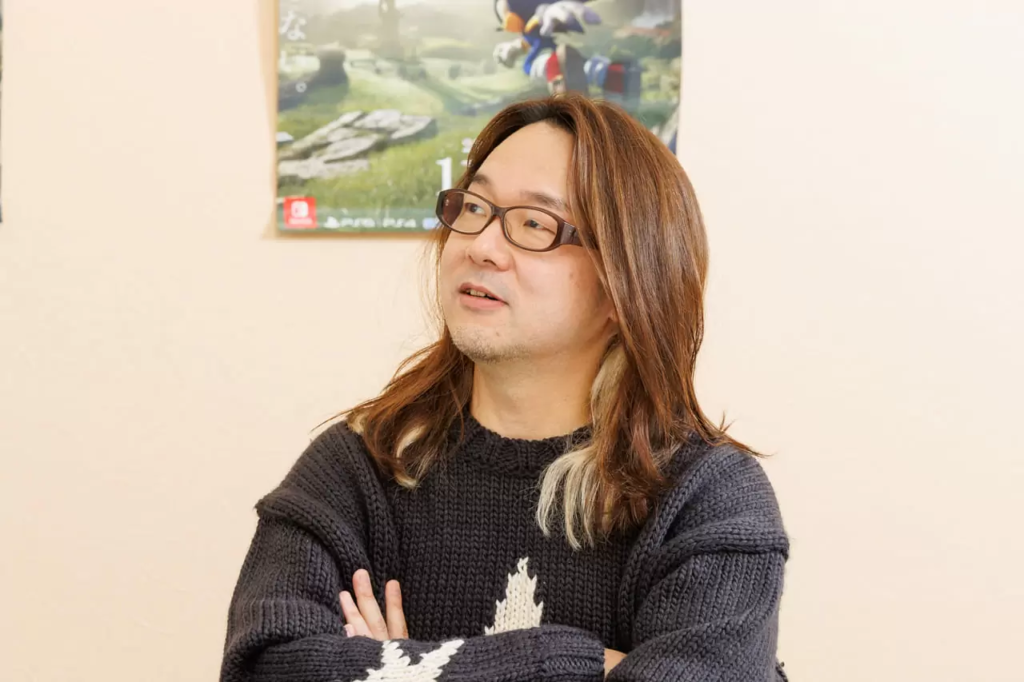
There is only one major difference: the game is interactive and progresses with the player, so “the composition of the music must be able to respond to changes as the game progresses”.
─ When you say ” must be able to respond to changes”, you mean…?
Ohtani: For example, in Sonic Frontiers, the battle music for the Titan battle starts playing when you encounter an enemy. There is a first form phase until a certain amount of damage is dealt, and then there is a second form phase when the enemy’s health decreases and their attacks become more ferocious.
The second form heats up the attack, so I want the song to have an exciting structure. But where the player transitions to the second form depends on the player. That’s why we used a mechanism called “block playback” to transition the song at the timing when the player transitions to the second form.

The timing of the defeat also differs from player to player, so when you deal the final blow, the music is structured in such a way that it ends with a clean “ta-da”. It’s not just a single track that starts with the intro and ends, but rather a “loop at a certain point, and when you’ve dealt all the damage, you’ll enter the next phase” kind of thing.
Sometimes game music needs to be composed with that in mind. I think that’s the only big difference.

─ How do you start making the very first song? Where did you start on Sonic Frontiers?
Ohtani: We started out with a song for the first island, Kronos Island. There was a prototype test island where Sonic could actually run around. I made it while running around on the island.
─ Like driving on a deserted island and thinking, “It would be nice if there was background music like this here”?
Ohtani: Yes, like that. The test island was just a grassy field and a few buildings, and the weather was a bit overcast. We wrote the song while running around the island. At first, I even wrote a more pastoral song, but there were requests that it should be a little darker. That it wasn’t too sad. The key word was “loneliness,” so I tried to find the right tone for it.
Come to think of it, in the early stages of the project, there was the possibility of “silencing the music”. Death Stranding and The Legend of Zelda: Breath of the Wild, which are also set in open fields, don’t have continuous background music, but rather phrases and songs that come in at the most effective times, and in Shadow of the Colossus, the fields basically just have environmental sounds. We were considering that possibility at first.

─ What is your opinion about silence, Mr. Otani?
Ohtani: There are many games I like that don’t have music in the field. But in this game, I prioritized the information conveyed by having music. Music is an important element of the Sonic series, so I thought we could try a new approach to music.

The improved graphics make the game photo-realistic, so I wanted to carefully prepare the sound effects and environmental sounds.
If you are near a river, you will hear water, birds will sing, and the wind will blow. The sound of footsteps also changes depending on which attribute of foothold you are walking on. We wanted the player to listen to these detailed expressions to heighten the sense of immersion, but if we filled the sound with groovy music, we’d lose the sense of atmosphere, so we chose quiet music for the islands.
You can turn off the background music completely by setting the volume, and if you explore the island in that state, you’ll discover a variety of ambient sounds.

─ You said that you play through fields with no background music to find the right music, does music start playing in your head as you play?
Ohtani: That’s basically it. I had an idea for the background music for the island right away, but what I wasn’t sure about was the song for the battle against the Titan. At first it wasn’t as metalcore or post-hardcore as it is now, and I was making it a bit more rock-oriented and dramatic. But I felt like the music didn’t live up to the anticipation and tension of being Super Sonic and facing the Titans.

It lacked the aggressiveness to produce the most exciting moments of the game. The game was also very trial-and-error in terms of the playable aspects of the Titan battle. That’s why the music didn’t stick right away.
─ I see. So it was difficult because the gameplay itself, which was supposed to match the game, wasn’t quite set in stone yet.
Ohtani: That’s right. No matter how good the atmosphere of the quiet parts of the island are, if the opposite parts aren’t expressed properly, it wouldn’t work as sound design for Sonic Frontiers or as a soundtrack for the Sonic series.

The vocal music is one of the most important pieces of the Sonic series, and we always try to figure out where to use it most effectively. The theme of the previous Sonic Forces game was friendship with a buddy, so the main theme would play during the tag team action. It’s also played during the main theme of the game.
When we thought about how we wanted to use the vocal music in Sonic Frontiers, we decided that the most exciting part of the game would be the song from the Titan battle as Super Sonic. It’s like a weapon for the production, so we put a lot of emphasis on using it in the most effective situations.
Elements of metalcore and post-hardcore with a Japanese essence.
─ What is your favorite genre of music, Otani-san?
Ohtani: I’ve always been a bit too eclectic to narrow it down to one genre. But the music that influenced me when I was at my most impressionable age, even in my late 40s, I think I’ll always love it as my original musical experience. For me, it’s punk rock.
I started out in punk rock, then I started liking alt-rock, and from there I started leaning towards folk music and dance music such as hip-hop. In terms of rock music, I was a fan of Linkin Park in the 2000s.
People who like punk and people who like metal often have arguments (laughs). It seems that the metal people who prefer the beauty of construction can’t tolerate the looseness of punk rock. We just end up going down the same road when we talk about this subject (laughs).
Everyone: (laughter).
Ohtani: I know the good points of both punk rock and metal, so I like to use both when necessary, and considering the sound design and the role of the songs on this album, I’ve given it more of a metal feel.
The main theme “I’m Here” also has elements of Western metalcore and post-hardcore, but it’s melodic and dramatic, maybe because it has a Japanese essence. It’s like emo enhanced in a Japanese way. Maybe that’s why some people from overseas say it’s like the opening song of an anime.

─ Is that something that is in the blood of the Japanese people?
Ohtani: I think “I’m Here” is a song that has an entrance from both the dramatic melodic side and the hard sounding side. After it was released, I received messages from my colleagues in different jobs within the company saying that it was really good. I’ve been doing this for about 20 years now, and I’ve never had anyone go out of their way to tell me what they thought of a new song when I released it (laughs).
一 Everyone: (Laughter).
─ “I’m Here” has a quiet tone for the first 30 seconds or so, were you worried about making the intro quiet?
Ohtani: To be honest, I was worried. I think it’s easier to grab the momentum from the intro. I’m sure Sonic fans are thinking, “Give me a song that gets the crowd going!” It took a lot of courage to start with a quiet piano intro. But I thought it was a necessary introduction to express Sonic Frontiers. It wasn’t until the vocals were added that I felt a definite response to this approach.
The main theme “I’m Here” is a challenge to see how far we can reach with the music to people who haven’t been paying attention to the Sonic series until now, so I’d be happy if a lot of people listen to it.
─ Then, please give us a message for the readers!
Ohtani: Sonic Frontiers is a massive game, but we put a lot of thought into the soundtrack from start to finish. We want you to play the game all the way to the end and listen to the true ending song “One Way Dream”. It contains a message from the Sonic Team.
If you don’t make it to that ending, you can listen to it on the soundtrack we’re planning to release on December 7 (laughs).
一Everyone: (Laughter).
─ Thank you very much. (Done)

In most cases, you probably fall in love with game music along with your game playing experience. I’ve never met game music that moved me so much after just one listen. “I’m Here” seems to immediately fulfill its role as the main theme.
The vocal songs for the Sonic series were created in an irregular way, using only singers who were artists working in bands. However, this was a way to maximize the potential of each singer, as the sound director, who was closest to the development team, created and provided the music based on his understanding of what songs would fit the game title.
By doing so, the music aspect of the series will be able to reach a demographic that hasn’t had their antennae up for the Sonic series before. Just like this author. My iPod Classic, which I haven’t updated in over a decade, will be updated when the Sonic Frontiers soundtrack is released.
Source: denfaminicogamer.jp
Discover more from Sonic City ⋆★ Sonic the Hedgehog News, Media, & Community ★⋆
Subscribe to get the latest posts sent to your email.






